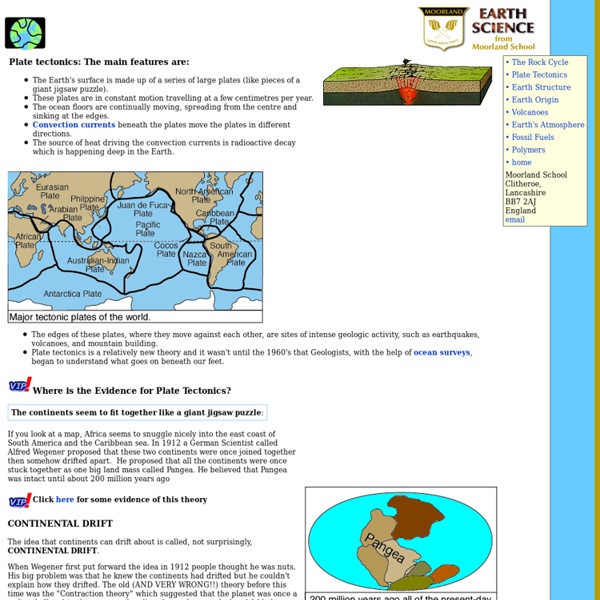Earth Floor: Plate Tectonics
Convergent Boundaries Places where plates crash or crunch together are called convergent boundaries. Plates only move a few centimeters each year, so collisions are very slow and last millions of years. Even though plate collisions take a long time, lots of interesting things happen. For example, in the drawing above, an oceanic plate has crashed into a continental plate. Are They Dangerous Places to Live? On the other hand, earthquakes and volcanoes occurring in areas where few people live harm no one. Back | Next
Animated Plate Tectonics
Quicktime versionAVI version Animated gifs Last 750 million years: [1.04 MB] [506 KB] [261 KB] Last 750 million years in reverse: [1.04 MB] [506 KB] From 750 mya to the beginning of the Paleozoic: [294 KB] [166 KB] From 750 mya to the beginning of the Mesozoic: [532 KB] [284 KB] [156 KB] From the beginning of the Mesozoic to Recent: [301 KB] [163 KB] [96 KB] All animations built from maps used with the permission of C.R. There are a number of excellent sites dealing with the modern theory of plate tectonics. The Paleomap project at the University of Texas at Arlington.Paleogeography Through Geologic Time by Ron Blakey at Northern Arizona University. Finally, it seems appropriate to mention the Alfred Wegener Institute, the German national research center for polar and marine research, carrying on Wegener's tradition of interdisciplinary earth science. Sources: S.
International Tsunami Information Center
Convergent boundary
Descriptions[edit] The nature of a convergent boundary depends on the type of plates that are colliding. Where a dense oceanic plate collides with a less-dense continental plate, the oceanic plate is typically thrust underneath because of the greater buoyancy of the continental lithosphere, forming a subduction zone. Where two continental plates collide the plates either buckle and compress or (in some cases) one plate delves called subduction, under the other. When two plates with oceanic crust converge, they typically create an island arc as one plate is subducted below the other. Not all plate boundaries are easily defined. Convergent margins[edit] A subduction zone is formed at a convergent plate boundary when one or both of the tectonic plates is composed of oceanic crust. An oceanic trench is found where the denser plate is subducted underneath the other plate. Some convergent margins have zones of active seafloor spreading behind the island arc, known as back-arc basins.
Volcano
A 2007 eruptive column at Mount Etna producing volcanic ash, pumice and lava bombs Santa Ana Volcano, El Salvador, a close up aerial view of the nested summit calderas and craters, along with the crater lake as seen from a United States Air Force C-130 Hercules flying above El Salvador. Erupting volcanoes can pose many hazards, not only in the immediate vicinity of the eruption. One such hazard is that volcanic ash can be a threat to aircraft, in particular those with jet engines where ash particles can be melted by the high operating temperature; the melted particles then adhere to the turbine blades and alter their shape, disrupting the operation of the turbine. Large eruptions can affect temperature as ash and droplets of sulfuric acid obscure the sun and cool the Earth's lower atmosphere (or troposphere); however, they also absorb heat radiated up from the Earth, thereby warming the upper atmosphere (or stratosphere). Etymology Plate tectonics Divergent plate boundaries "Hotspots"
World Physical MapMaker Kit
About This MapMaker Kit The World Physical MapMaker Kit maps includes a map without country boundaries, city names, and other political features. For a world map with country boundaries see the World Political MapMaker Kit. Download, print, and assemble maps of the physical world in a variety of sizes. The mega map occupies a large wall, or can be used on the floor. Download the MapMaker Kit Download the maps from the carousel above, or from the links below.
World Political MapMaker Kit
About This MapMaker Kit The World Political MapMaker Kit maps include country boundaries, city names, and other political features. For a world map without country boundaries see the World Physical MapMaker Kit. Download, print, and assemble maps of the political world in a variety of sizes. Watch the tutorial video above to get started. Then download each piece of the MapMaker Kit as a PDF file. The mega map occupies a large wall, or can be used on the floor. Download the MapMaker Kit Download the maps from the carousel above, or from the links below.



